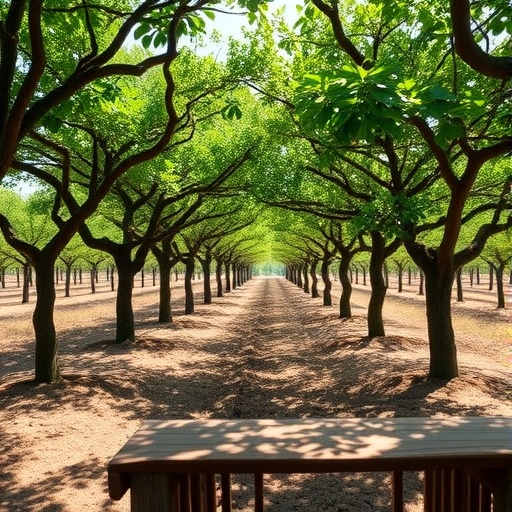Recent research conducted by scientists at the University of Queensland has uncovered a groundbreaking strategy to mitigate greenhouse gas emissions within the global chocolate industry. This approach centers on the integration of increased shade tree coverage within cocoa farming landscapes, specifically focusing on the principal cocoa-producing regions of West Africa. These regions, notably Ghana and Côte d’Ivoire, contribute approximately 60 percent of the world’s cocoa supply, positioning any advancements here as significantly influential on a global scale.
The interdisciplinary research team, spearheaded by Dr. Wilma Blaser-Hart and Dr. Simon Hart from UQ’s School of the Environment and the Centre for Biodiversity and Conservation Science, employed a sophisticated blend of remote sensing technologies and machine learning algorithms. By analyzing satellite imagery, they quantified the extent of shade tree presence within existing cocoa cultivation areas, revealing that tree cover currently averages only around 13 percent. This figure is markedly below the optimal threshold for balancing agricultural productivity with carbon sequestration potential.
Cocoa naturally thrives as an understory species within tropical rainforests, benefiting from the protective canopy provided by taller trees. However, contemporary monoculture practices often expose cocoa plants to direct sunlight by removing much of this natural shading. Such exposure, while historically aimed at maximizing yields, inadvertently diminishes the ecosystem services provided by shade trees, including carbon storage, biodiversity support, and microclimate regulation.
The study’s findings suggest that increasing shade tree coverage on cocoa farms to between 30 and 50 percent does not compromise yield; rather, it unlocks the ability of these agroforestry systems to sequester considerable amounts of atmospheric carbon dioxide. This enhanced tree presence stores carbon in both aboveground biomass—such as trunks and foliage—and belowground biomass, including roots and soil organic matter, creating a robust carbon sink within agricultural landscapes.
Quantitatively, elevating shade tree cover to at least 30 percent across cocoa farms in Ghana and Côte d’Ivoire could potentially sequester an estimated 10.2 million tonnes of CO₂ equivalent annually in the coming decades. This carbon sequestration capacity alone equates to nearly 9 percent of the two countries’ total annual greenhouse gas emissions. When focusing solely on emissions directly attributable to cocoa farming activities, the offset potential climbs dramatically to approximately 167 percent, underscoring the significant climate mitigation opportunity that agroforestry presents.
However, the researchers emphasize that this carbon offset advantage is moderated when considering emissions from historical land-use changes, including deforestation that frequently precedes agricultural development. Even accounting for these factors, the carbon storage gains from tree planting on farms still represent about 15 percent of the cocoa sector’s annual emissions, making it a meaningful, though not exhaustive, climate solution.
Beyond carbon dynamics, the expansion of shade trees within cocoa systems delivers multiple environmental benefits. Diverse tree species foster enriched biodiversity, acting as habitats for a variety of flora and fauna often displaced by monoculture farming. Additionally, improved soil fertility arises from enhanced organic matter input, root structure stabilization, and nitrogen fixation when leguminous trees are included. Shade trees also contribute to microclimate regulation by buffering temperature extremes, maintaining humidity, and reducing evapotranspiration rates.
Critically, ecological resilience in agricultural landscapes is further strengthened by shade trees reducing pest and disease incidence. By promoting natural predator populations and enhancing habitat complexity, these agroforestry systems can lower reliance on chemical pesticides, contributing to more sustainable management practices. This holistic environmental uplift aligns with global goals for climate action, biodiversity conservation, and food security.
While the research endorses agroforestry as a powerful mitigation tool, Dr. Blaser-Hart and colleagues caution against viewing tree planting as a substitute for natural forest conservation. Intact tropical forests remain irreplaceable reservoirs of carbon, biodiversity, and ecosystem services. The gains from cocoa agroforestry, although substantial, only approximate the carbon storage found within the limited remaining pristine forest patches in West Africa, reaffirming the overarching priority of tropical forest protection.
The innovative methodology deployed in this study—combining satellite remote sensing with advanced machine learning—affords high-resolution, landscape-scale monitoring of agroforestry practices. This technological framework paves the way for replicating similar analyses in other crucial cocoa-producing regions such as South America and Southeast Asia. Further, its applicability extends beyond cocoa to other perennial crops that benefit from shade, like coffee, opening pathways toward widespread sustainable agricultural intensification.
Of particular note is the dual advantage offered by shade tree integration: environmental benefits paired with the preservation of crop yields. Contrary to traditional assumptions that shading inherently reduces agricultural productivity, the findings highlight a “win-win” scenario. Cocoa farmers can contribute meaningfully to climate mitigation efforts without relinquishing economic returns, thus bridging socio-economic and environmental objectives.
This research was supported by multiple stakeholders including the Lindt Cocoa Foundation, the Joint Cocoa Research Fund of CAOBISCO and ECA, the BiodivClim ERA-Net COFUND programme, and the Queensland Government Women’s Research Assistance Program. The results have been published in the prestigious journal Nature Sustainability, providing a rigorous, peer-reviewed foundation for policy formulation and industry shifts toward agroecological farming systems.
As the global chocolate industry faces mounting pressures to reduce its carbon footprint and enhance sustainability, this innovative agroforestry pathway presents a viable and scalable climate action strategy. The integration of shade trees into cocoa production not only embodies a regenerative approach to farming but also establishes a crucial linkage between agricultural landscapes and global carbon cycles, highlighting the untapped potential of land management in addressing climate change.
Subject of Research: Agroforestry and carbon sequestration in cocoa farming systems.
Article Title: The unrealized potential of agroforestry for an emissions-intensive agricultural commodity.
News Publication Date: 6-Aug-2025.
Web References:
- https://doi.org/10.1038/s41893-025-01608-7
- https://about.uq.edu.au/experts/27450
- https://about.uq.edu.au/experts/25887
- https://environment.uq.edu.au/
- https://cbcs.centre.uq.edu.au/
References: Blaser-Hart, W., Hart, S., et al. (2025). The unrealized potential of agroforestry for an emissions-intensive agricultural commodity. Nature Sustainability. https://doi.org/10.1038/s41893-025-01608-7
Keywords: Agroforestry, Environmental policy, Climate change, Forestry, Crop production, Crop yields




